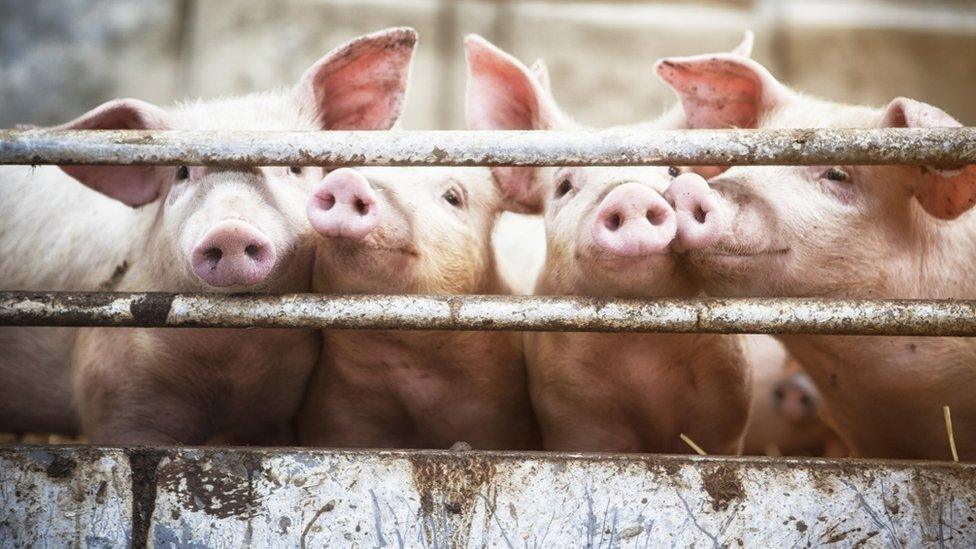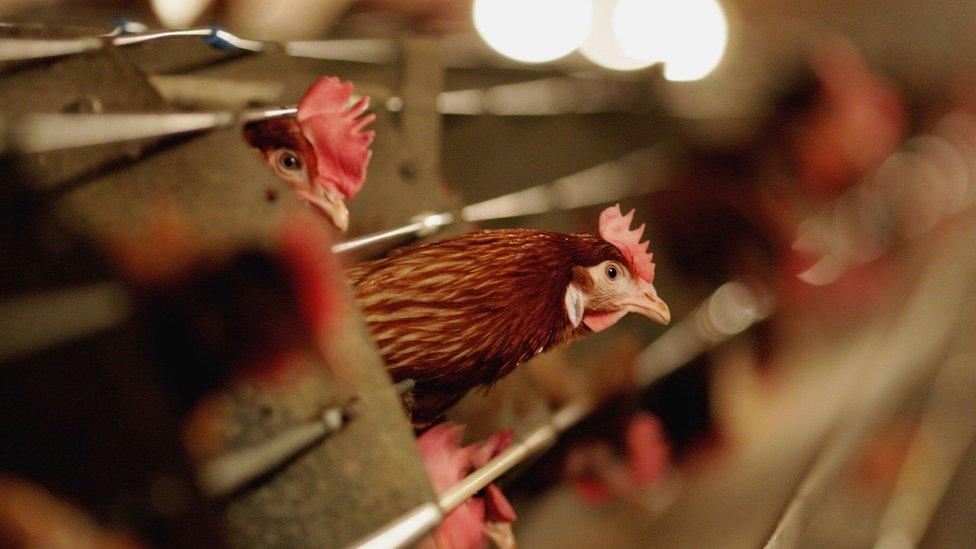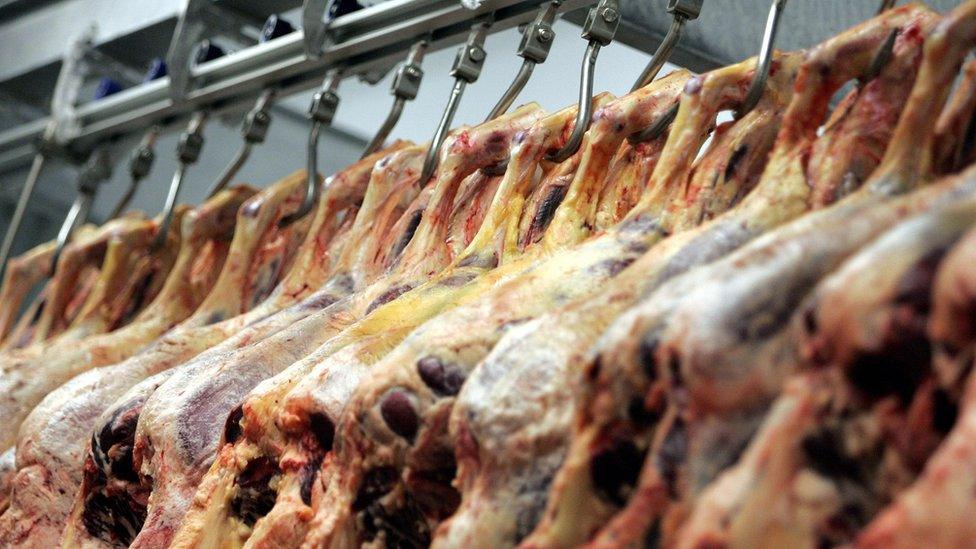Is it cruel to stun animals with carbon dioxide?
- Published
- comments

The carbon dioxide shortage has focused attention on the methods used to stun animals, but is there be a better way?
An abattoir in Brechin in Angus, Scotland usually processes about 6,000 pigs from Scottish farmers every week.
But it has been standing empty now for over a week.
Due to the CO2 shortage affecting various parts of the UK food industry from beer to crumpets, Scotland's largest pig processor has had to stop work.
Without carbon dioxide there is no way to stun the animals before slaughter.
And with uncertainty about deliveries despite CO2 production resuming, Scottish farmers are left to manage the impact on their livestock.
Quality Pork Limited, which owns the Brechin abattoir, can only find alternative capacity for 400 animals a day, several hours away at its other plant in Ashton-under-Lyne, Manchester.
That, along with the threat of overcrowding at farms, has focused attention on animal welfare, and prompted a bigger question: whether carbon dioxide is an appropriate way of dispatching pigs at all.
'Gasp and panic'
The animal welfare campaigners, Compassion in World Farming, say using the gas to make pigs unconscious is a "horrible death".
"In concentrated carbon dioxide, pigs will panic, try desperately try to escape and gasp, before falling down and losing consciousness up to a minute later [according to some sources] and possibly longer," said Philip Brook of CIWF.
The CO2 method does not meet the definition of humane slaughter, he argues, since the stunning does not take place instantly, and CIWF is calling for the government to ban this method within five years.
However, others dispute this interpretation. The Humane Slaughter Association, a charity promoting animal welfare within the food production system, suggests that while pigs do "exhibit strong reactions for a period of up to 30 seconds ... carbon dioxide also has a direct anaesthetic effect" resulting in a faster loss of consciousness than with other gas mixtures.

European and UK law stipulate that animals must be effectively stunned before slaughter, apart from exceptions for some religious circumstances.
Over the past century, methods have evolved from pole-axing to electric shocks and more recently suffocation with gas.
While sheep and cattle are still mostly stunned using a captive-bolt stun pistol, pigs and poultry are now more often stunned using carbon dioxide.
There's a growing consensus that poultry stunned with CO2 suffer far less than with the alternative "electric bath" method. That involves hanging the birds upside down on a production line where their heads are dipped in water charged with an electric current.
Not only is the suspension and shackling distressing, there is a risk they will flap a wing and suffer a minor shock, or twist and escape shocking altogether.
Using CO2, the birds remain in their original container which is moved into an atmosphere with 40% carbon dioxide concentration - enough to make them lose consciousness. It is widely regarded as a less cruel method of dispatch.
Social animals
There is no consensus over the use of CO2 to slaughter pigs, however.
Pigs are stunned using a 70% to 90% carbon dioxide concentrate. They are typically loaded in groups of about half a dozen onto something like a paternoster lift, which lowers them gradually into ever higher concentrations of the gas.
Once the animals have been stunned, they must be bled within 15 seconds to avoid the risk of them regaining consciousness.

Slaughterhouse owners say they feel pressured to install CCTV to succeed in getting grants
Using an electric stun-gun, a method still used in some abattoirs, is instantaneous. However, it requires pigs to be separated from the rest of the group.
As highly social animals, this causes significant distress, according to the Humane Slaughter Association (HSA). There is also a risk that the animals will not be properly stunned due to human error.
Abattoirs effectively face a choice between causing short-term physical distress, or social distress over a longer period of time.
Low pressure solution
The HSA and the Department for the Environment and Rural Affairs is researching alternative methods of stunning pigs and believe a solution is close.
Observations of RAF pilots experiencing low pressure atmospheres suggest that the sensation is not unpleasant. As the air thins, they may be in danger of losing consciousness, but they do not experience gasping or suffocation.
That crucial finding has informed the development of a new stunning method called LAPS, or low atmospheric pressure stunning, which has already been approved in the EU for chicken slaughter.
It could be available for abattoirs processing pigs within a few years, says the HSA, but because pigs' respiratory systems are very different to those of poultry, there is still work to be done.
"The LAPS system is very new," says Robert Hubrecht, chief executive of the HSA. "There is a commercial one or two being used in the States but its' not widely used yet.
"With pigs it's still very much at experimental stage. You have to show the regulatory authorities that it is consistently humane."
But he says the method shows a lot of promise.
Veterinary role
While the CIWF welcomes the new technique, it seeks a greater sense of urgency and the exploration of more alternatives.
But the British Veterinary Association says if there was undue suffering of animals in abattoirs, vets - who are legally required to be present in slaughterhouses - would be speaking out.
"We should be proud of our abattoirs," says BVA president John Fishwick, who points out that CCTV is now mandatory in all areas where live animals are held.
"We should be extremely pleased with the methods and standards in our abattoirs. Veterinary surgeons have great authority to stop the line if they are not happy about anything and they take that responsibility very seriously."
- Published4 July 2018

- Published2 July 2018
